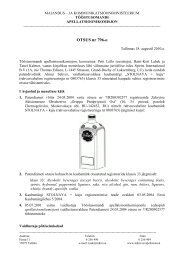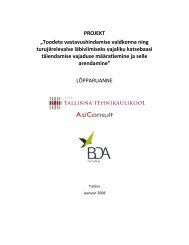Feasibility study for an Estonian Materials Technology Programme
Feasibility study for an Estonian Materials Technology Programme
Feasibility study for an Estonian Materials Technology Programme
You also want an ePaper? Increase the reach of your titles
YUMPU automatically turns print PDFs into web optimized ePapers that Google loves.
61<br />
<strong>Feasibility</strong> <strong>study</strong> <strong>for</strong> <strong>an</strong> Estoni<strong>an</strong> <strong>Materials</strong> <strong>Technology</strong> <strong>Programme</strong><br />
2. <strong>Materials</strong> technology in Estonia<br />
Case: Skeleton Technologies<br />
Background<br />
Skeleton Technologies is developing <strong>an</strong>d producing supercapacitors <strong>an</strong>d energy storage materials. History dates<br />
back to Tartu Tehnoloogiad OÜ, founded in 1997 as a research arm, <strong>for</strong> materials development <strong>for</strong> carbide<br />
derived carbon <strong>an</strong>d supercapacitors, of the <strong>for</strong>mer Skeleton Technologies Group having R&D facilities in<br />
Sweden, Switzerl<strong>an</strong>d, US, <strong>an</strong>d Russia. During 2000-2007 the comp<strong>an</strong>y also carried out contract research <strong>for</strong><br />
world´s leading comp<strong>an</strong>ies such as Toyota Motor Corporation, Samsung SDI, Honeywell Chemicals During<br />
that period the comp<strong>an</strong>y generated revenue of ca 2 M USD <strong>an</strong>d effectively returned the initial investment.<br />
Contract research started to wind down in 2005 after <strong>an</strong> intellectual property dispute with Toyota. In 2008 <strong>an</strong><br />
attempt to commercialize the technology was made by <strong>for</strong>ming Carbon N<strong>an</strong>otech. Due to lack of vision <strong>an</strong>d not<br />
underst<strong>an</strong>ding the market needs, Carbon N<strong>an</strong>otech went b<strong>an</strong>krupt.<br />
Skeleton Technologies was founded in 2009 by a new business development team led by Anti Perkson <strong>an</strong>d Taavi<br />
Madiberk who bought out the assets. The goal is to commercialize the supercapacitor technology. Currently<br />
the comp<strong>an</strong>y has successfully attracted customer leads including General Motors, Samsung SDI, Peugeot, <strong>an</strong>d<br />
Citröen. Main competitors include IOXUS. Skeleton Technologies has been given the same r<strong>an</strong>king in technology<br />
<strong>an</strong>d business development as IOXUS by Lux Research.<br />
<strong>Technology</strong> <strong>an</strong>d R&D<br />
Ultracapacitors have gained ground as a solution to energy storage problems in applications where batteries<br />
<strong>an</strong>d conventional electrolytic capacitors are unsuitable. Ultracapacitors offer the unique combination of high<br />
power <strong>an</strong>d energy densities at very fast reaction times <strong>for</strong> short periods of time as well as store <strong>an</strong>d release<br />
energy with a subst<strong>an</strong>tially higher efficiency rate (95%+) th<strong>an</strong> batteries. Why Ultracapacitors? 1) The problem<br />
of fuel/energy costs is subst<strong>an</strong>tial in the automotive <strong>an</strong>d locomotive industry. Ultracapacitors capture <strong>an</strong>d<br />
release energy, which would be otherwise lost. 2) Ultracapacitors combined with batteries are used to eliminate<br />
damages from power outages accounting <strong>for</strong> up to 100 B USD in damages in the U.S. alone.<br />
Skeleton Technologies could produce supercapacitors in similar size th<strong>an</strong> its competitors, but with up to twice as<br />
high power density per volume <strong>an</strong>d twice as high energy density per volume. These results have been verified by<br />
University of Cali<strong>for</strong>nia. Skeleton Technologies proposes to reduce costs <strong>for</strong> the end-users by lowering the<br />
price of ultracapacitors by 2-4 times, which could possibly be disruptive <strong>for</strong> the entire ultracapacitors market.<br />
Skeleton Technologies also differentiates from competitors by developing both the material <strong>an</strong>d the supercapacitors.<br />
The latter is closest to commercialization, but wide-scale research carried out over the years has<br />
shown the carbon material’s superiority in other fields as well. Examples include actuator material in robotics<br />
with University of Tartu Prof. Alvo Aabloo, <strong>an</strong> absorber material with Uppsala University, <strong>an</strong>d a gas purification<br />
material with Max Pl<strong>an</strong>ck Institute. Currently, a 1-year 200 000 EUR R&D contract is under way with Europe<strong>an</strong><br />
Space Agency <strong>an</strong>d the comp<strong>an</strong>y is participating in a hybrid capacitor FP7 project. Since 1997 there has also<br />
been scientific cooperation with University of Tartu.<br />
<strong>Technology</strong> commercialisation<br />
After the long technology development process, Skeleton Technologies’ supercapacitors are now ready <strong>for</strong><br />
production scale-up. The biggest challenge <strong>for</strong> scaling up the production is the lack of fin<strong>an</strong>cing. As it is<br />
relatively difficult to find skilled work<strong>for</strong>ce in Estonia <strong>for</strong> development <strong>an</strong>d production of the high technology<br />
supercapacitors, Skeleton Technologies has created contacts with international experts that c<strong>an</strong> be recruited<br />
after securing fin<strong>an</strong>cing.<br />
Skeleton Technologies is in the process of applying <strong>for</strong> a Government Gr<strong>an</strong>t matched with private investments<br />
to develop a cost-effective scalable production technology. Small-scale commercial m<strong>an</strong>ufacturing is pl<strong>an</strong>ned to<br />
be launched in 2013 <strong>an</strong>d full-scale m<strong>an</strong>ufacturing in 2014-2015. The State of Michig<strong>an</strong> <strong>an</strong>d Columbus, Ohio in<br />
the US <strong>an</strong>d some Germ<strong>an</strong> regions have expressed interest in bringing Skeleton´s R&D <strong>an</strong>d potential production<br />
to their locations.<br />
Challenges<br />
For a small comp<strong>an</strong>y it is difficult to find partners <strong>an</strong>d funding nationally <strong>an</strong>d thus the comp<strong>an</strong>y needs to talk<br />
with large global players. It is, however, very difficult to stay independent <strong>an</strong>d at least currently the comp<strong>an</strong>y<br />
wishes to establish production in Estonia supported with capital investment rather th<strong>an</strong> licensing the technology,<br />
also seeing national funding instruments as <strong>an</strong> incentive.





